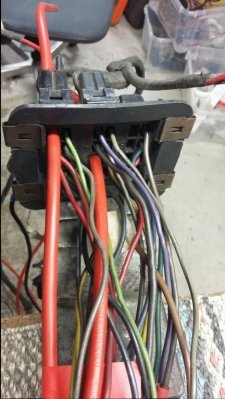vegiguy
Well-Known Member
This is related to the amp meter elimination post but I decided it needed a separate post on it's own. Mopar had their own way of wiring the 60 amp and up alternators on B-bodies (and other models) that still used the ammeter. Basically it involved running a 6 or 8 gauge wire off of the alternator and splitting it into two 10 gauge wires: one of the 10 gauge legs goes thru a grommet in the firewall to one side of the ammeter, and then from the other side of the ammeter a 10 gauge wire goes back thru the grommet in the firewall thru a 14 gauge fusible link to the starter relay battery terminal. The other 10 gauge leg off of the 8 gauge alternator wire goes thru a 16 gauge fusible link back to a 12 gauge wire and into opening 18 the bulkhead connector to power the main dash splice. The original black and red 12 gauge wires going to the ammeter are cut and the ends taped. The original red wire with the fusible link on it going from the bulkhead connector opening 16 gets removed. Mopar at some point apparently recognized the weakness of their bulkhead connector for running large amounts of power thru it and thought this would take some of the load off of terminals 16 and 18.
I've discussed the upper wiring with an auto electric repairman I trust and he seems to think this is a decent way to wire the system and still keep the ammeter. I brought up the ammeter burning issue and he thought that was caused by loose connections and can be avoided if the connections are kept tight and in good condition. He did admit to doing a lot of repairs to Mopar bulkhead connectors by drilling thru the plastic connector and running the wire straight thru it as in the MAD fix.
I've thought about doing the MAD fix and listened to Mark's spiel about it but I can't bring myself to drilling thru my perfectly good bulkhead connector to do it. Plus I don't like the idea of not being able to service the system with cutting and re-splicing wires in addition to not being original looking which is important to me. My question is: does anyone have a picture of a B-body that was actually wired in the above manor? I'm trying to figure out where the grommet actually was where the main power wires went thru to go to and from the ammeter. If someone could post a picture of this set-up I sure would appreciate it.
I've discussed the upper wiring with an auto electric repairman I trust and he seems to think this is a decent way to wire the system and still keep the ammeter. I brought up the ammeter burning issue and he thought that was caused by loose connections and can be avoided if the connections are kept tight and in good condition. He did admit to doing a lot of repairs to Mopar bulkhead connectors by drilling thru the plastic connector and running the wire straight thru it as in the MAD fix.
I've thought about doing the MAD fix and listened to Mark's spiel about it but I can't bring myself to drilling thru my perfectly good bulkhead connector to do it. Plus I don't like the idea of not being able to service the system with cutting and re-splicing wires in addition to not being original looking which is important to me. My question is: does anyone have a picture of a B-body that was actually wired in the above manor? I'm trying to figure out where the grommet actually was where the main power wires went thru to go to and from the ammeter. If someone could post a picture of this set-up I sure would appreciate it.


















